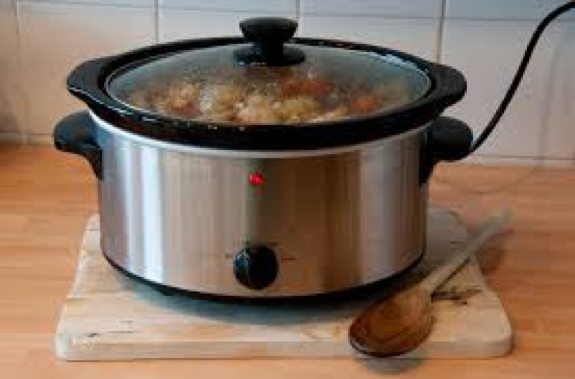Keeping Foods Safe in a Slow Cooker
go.ncsu.edu/readext?742498
en Español / em Português
El inglés es el idioma de control de esta página. En la medida en que haya algún conflicto entre la traducción al inglés y la traducción, el inglés prevalece.
Al hacer clic en el enlace de traducción se activa un servicio de traducción gratuito para convertir la página al español. Al igual que con cualquier traducción por Internet, la conversión no es sensible al contexto y puede que no traduzca el texto en su significado original. NC State Extension no garantiza la exactitud del texto traducido. Por favor, tenga en cuenta que algunas aplicaciones y/o servicios pueden no funcionar como se espera cuando se traducen.
Português
Inglês é o idioma de controle desta página. Na medida que haja algum conflito entre o texto original em Inglês e a tradução, o Inglês prevalece.
Ao clicar no link de tradução, um serviço gratuito de tradução será ativado para converter a página para o Português. Como em qualquer tradução pela internet, a conversão não é sensivel ao contexto e pode não ocorrer a tradução para o significado orginal. O serviço de Extensão da Carolina do Norte (NC State Extension) não garante a exatidão do texto traduzido. Por favor, observe que algumas funções ou serviços podem não funcionar como esperado após a tradução.
English
English is the controlling language of this page. To the extent there is any conflict between the English text and the translation, English controls.
Clicking on the translation link activates a free translation service to convert the page to Spanish. As with any Internet translation, the conversion is not context-sensitive and may not translate the text to its original meaning. NC State Extension does not guarantee the accuracy of the translated text. Please note that some applications and/or services may not function as expected when translated.
Collapse ▲Do your cooking methods and equipment change with the seasons? Backyard grilling (or in my case, back porch grilling) is one of the most popular summer cooking methods. Nothing says summer better than the smell of a smoky grill, cooking up some burgers or BBQ for dinner. Now that the temperatures are falling and Autumn is in the air, there is just something about needing comfort foods that only a slow cooker can provide. From hearty soups and stews to pot roasts, vegetables, and slow-cooked desserts, there are a plethora of slow cooker recipes to choose from. In addition to satisfying those cold-weather cravings, a meal prepared in a slow cooker saves time. After a long day of work and running the kids to piano lessons or basketball practice, coming home to the smell of a pot roast with yummy vegetables simmering in the slow cooker does a momma’s heart good. Cook up a few quick sides of whole grain rice, cinnamon applesauce, and a dinner roll and wah-lah, a home-cooked meal is served in less than 20 minutes!
While we can enjoy the time-saving method of slow cooker meals, it is important to ensure foods are prepared in a safe manner to avoid the possibility of foodborne illness. Here are a few ways to monitor for food safety when using a slow cooker:
- Always wash hands before preparing food.
- Pre-heat cooker.
- Always thaw meat and poultry first. Do not put frozen meat in a slow cooker.
- Add liquid according to the recipe. The liquid helps to create steam needed to cook the food.
- Do not cook on warm which is designed to keep already hot foods hot.
- Keep the lid on during the entire cooking time to maintain the temperature.
- Once the cooking time is complete, check the food with a thermometer before eating to make sure it has reached a safe temperature.
Multi-cookers such as an Instant Pot, offer another option of quick-cooking equipment. These multi-functional devices cook foods at high and low temps and they have tons of functions, including pressure cooking, slow cooking, rice cooking, steaming, warming, and sautéing. It is still important to pay attention to food safety when using a multi-cooker. Follow the manufacturer’s instructions and tested recipes for settings and cooking times. Be careful when using the delay feature because foods left at room temperature are at risk of bacteria multiplying rapidly and causing foodborne illness. Always use a thermometer to make sure food has reached a safe temperature and refrigerate or freeze leftovers immediately and do not store food in the pot.
For more information on using slow or multi-cookers or for yummy recipes, contact Kim Terrell, Family and Consumer Science Agent at 828-389-6305 or kimberly_terrell@ncsu.edu.
For more food safety tips visit:
NC State Extension Food Safety website
Federal Food Safety Information
Featured Recipe
Slow Cooker Apple Cobbler
Ingredients
- 6 cups sliced peeled tart apples
- 1 ¼ tsp ground cinnamon
- ¼ tsp ground allspice
- ¼ tsp ground nutmeg
- ¾ c 2% milk
- 2 Tbsp butter, softened
- ¾ c sugar
- 2 large eggs
- 1 tsp vanilla extract
- ½ c biscuit baking mix
Topping:
- 1 c biscuit baking mix
- 1/3 c packed brown sugar
- 3 Tbsp cold butter
- ½ c sliced almonds
- Ice cream or whipped topping, optional
Directions
- In a large bowl, toss apples with cinnamon, allspice, and nutmeg. Place in a greased 3-quart slow cooker. In a small bowl, combine the milk, butter, sugar, eggs, vanilla, and biscuit mix. Spoon over apples.
- For the topping, combine biscuit mix and brown sugar in a large bowl; cut in butter until crumbly. Add almonds; sprinkle over apples.
- Cover and cook on low for 6-8 hours or until the apples are tender. Serve with ice cream or whipped cream if desired.




